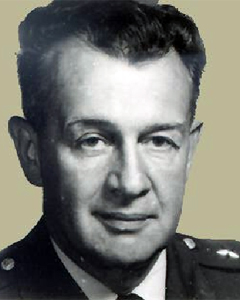Major General
John G. Zierdt
 Major General John Graham
Zierdt was born in Ashley, Pennsylvania on February 17, 1913.
Major General John Graham
Zierdt was born in Ashley, Pennsylvania on February 17, 1913.
He held key positions in the U.S. Army missile program for more than a decade of change in both technology and management of major weapons programs. He was a key contributor in the fielding of the Redstone Ballistic Missile (the free world's first operational large ballistic missile system); the development of the Jupiter intermediate range ballistic missile; and the American space program.
In 1960, he became the U.S. Army's first project manager, directing the development and deployment of the Nike Zeus antimissile system. He later became the Commander U.S. Army Rocket and Guided Missile Agency. He commanded Army test operations at Kwajalein Atol which later became the Kwajalein Missile Range. He centralized direction and control while serving as Deputy Director, Research and Development, U.S. Army Materiel Command in 1962 through 1963. This resulted in concentrating Army high energy laser research at Redstone Arsenal and missile development of laser semiactive guidance technology, applied in the “smart bombs” employed by U.S. forces in the later stages of the Vietnam Conflict.
As Commander of the U.S. Army Missile Command and Redstone Arsenal, Alabama from 1963 to 1967, he led the Army missile team. Fielding of the Nike Hercules and basic Hawk air defense guided missile systems and the Pershing ballistic missile system were completed under his leadership. Engineering development under his direction resulted in the new generation of precision-guided battlefield weapons. Because of his efforts, it was possible for the Army to field the 2.75 rocket system with Army helicopters at the onset of the Vietnam Conflict, and this work also led to the helicopter use of the TOW system.
As Commander at Redstone Arsenal, General Zierdt rebuilt and strengthened the Army's in-house missile research, development, and engineering capabilities. General Zierdt retired in 1967.